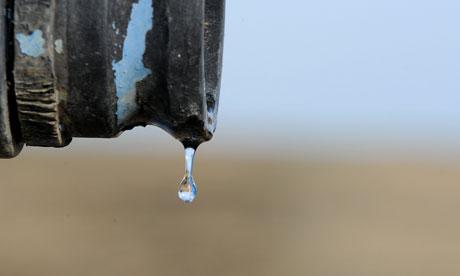 China's wather shortfall has put its industry, agriculture and domestic demand on collision course. Photograph: Robyn Beck/AFP/Getty Images
China's wather shortfall has put its industry, agriculture and domestic demand on collision course. Photograph: Robyn Beck/AFP/Getty ImagesChina's 2030 net water demand will be 818 billion cubic meters, while current annual supply is only 618 billiion cubic meters. Of this 2030 net water demand, about 50% will be for agriculture, 32% for industry, and 18% for domestic use - leaving a daunting 24% supply gap.
This projected shortfall puts agriculture, industry, and domestic demand on a collision course. Exacerbating the problem further are uncertainties in the scale and scope of climate impacts on the water supply, the increasing unusability of water for agriculture due to industrial pollution, and the growing water intensity of a manufacturing economy powered largely by coal.
Industry v agriculture
It is industry that will be responsible for most of the growth in water demand between now and 2030. Currently, industrial water use accounts for only 23% of the water mix, with a large percentage of that water being used to operate and cool China's rapidly growing coal energy infrastructure. The increase in the industrial portion of the overall water mix from 23% currently to 32% by 2030 will be driven to a large extent by increases in coal-fueled energy to power economic growth. In China, 21% of available fresh water is already unusable for agriculture due to pollution, and rising.
This will create a growing tension between industry and agriculture. China's bread basket consists of seven northern provinces: Heilongjiang, Jilin, Liaoning, Hebei, Shanxi, Beijing, Tianjin. These regions produce 25% of China's grain. In recent years, drought increases in these dry regions have adversely impacted agricultural output more than all other environmental disasters combined. Compounding this is the rise of industrial water pollution.
For the Chinese government, this will mean tough policy choices, and difficult trade-offs. Already, countries south of China are complaining that Chinese dams are reducing water supply to the almost 70 million non-Chinese individuals dependant on south east Asian river deltas for subsistence agriculture.
Domestic water shortages are also becoming more commonplace. Currently, over 65% of Chinese cities suffer from domestic water shortage. For example, Beijing consumed 3.11 billion cubic meters of water last year, despite a local supply of only 2.18 billion cubic meters, and this year was melting snow and importing water (from neighbouring drought stricken Hebei) to help offset demand.
Paying for water
Despite shortages, Chinese consumers are resistant to rising water prices. In the face of already moderate inflation, many fear that increases in commercial water prices will push up the cost of other goods, and that residential water prices will unfairly increase the cost of living for individuals at the margins of poverty.
According to The Economist, 2009 water price increases by several municipalities - including Beijing and Shanghai and during a period of slowing deflation - led to civic outrage, with one Chinese newspaper claiming that further price increases could act as a "powder keg" for civil unrest.
In November, China's water ministry responded to growing scarcity concerns by foreshadowing a series of coming water policies. Sun Xuetao, director general of the ministry's Water Resource Management department announced that by 2015 net water usage would be capped at 620 billion cubic meters (not coincidentally equal to net supply).
Sun also announced that China would achieve a 30% improvement in water efficiency per $1500 of industrial activity, large scale improvements in irrigation efficiency within agriculture, and significant reductions in lake and river pollution - over the same period. For now, all bets are on technology to close the gap.
Though significant price increases, currently constrained by inflationary fears in China's fast growth economy, can't be ruled out.
Scarcity and waste
Water scarcity will mean different things to different industrial sectors in different regions. Thermal coal power will be common to all regions, and is expected to make up 31% of industrial water usage in 2030, powering a significant portion of most industries. Yet non-energy water usage in textiles (10%), paper (7%), steel (5%), food and beverage (7%), chemicals (3%), coal and oil extraction (2%), and manufacturing (15%) will make up an additional combined 49% of industrial water usage by 2030.
All industries will be under increasing pressure to constrain their water and water-heavy energy usage. Industries favourable to the economic use of clean energy are likely to gain competitive advantages.
Water scarcity and pollution will increase pressure to improve waste water treatment. Currently, large amounts of industrial contaminants are being put into China's water supply.
Water scarcity and the emerging policy response to it will increase the cost of doing business in China. Smart companies will move fast to position themselves for technological advantage, access to clean energy, avoidance of reputational risk, and preparedness for policy change.
Related News
Photos
More>>trade
market
finance
- Mastronardi Produce once again named One of Canada's 50 Best Managed Companies
- Colombia and China discuss US$7.6B Pacific-Atlantic railway line
- China: Zhangpu Yicai vegetable season comes to an end
- T18 Group introduced new tricolour packaging at Fruit Logistica 2011
- Tozer's Wildfir rocket variety helps Bakkavor achieve first to market launch





